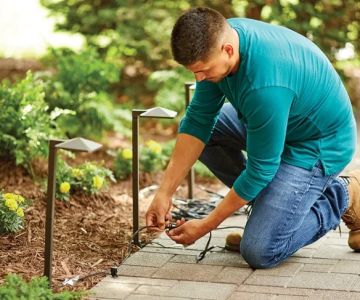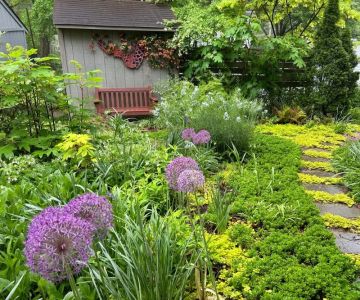How to Design a Sensory Garden (Smell, Touch, Sound)
- 1-Understanding Sensory Gardens
- 2-Benefits of Sensory Gardens
- 3-Key Elements of a Sensory Garden
- 4-Step-by-Step Guide to Designing a Sensory Garden
- 5-How Beautiful Landscapes Can Help
1. Understanding Sensory Gardens
Sensory gardens are designed to engage all five senses—smell, touch, sight, sound, and taste—in order to create an immersive, interactive outdoor experience. These gardens are perfect for individuals who may benefit from a calming and therapeutic environment, such as children, the elderly, or people with special needs. By thoughtfully incorporating a variety of plants, textures, and sounds, a sensory garden can help stimulate the mind, relax the body, and enhance overall well-being.
The focus of this article is on designing a sensory garden that emphasizes three primary senses: smell, touch, and sound. Each of these elements plays an essential role in creating a garden space that promotes relaxation, mental clarity, and a deeper connection with nature.
2. Benefits of Sensory Gardens
Designing a sensory garden can offer a wide range of benefits, not only for individuals with specific needs but also for anyone looking to enjoy the therapeutic effects of nature. Here are some key advantages:
- Enhances Mental Health: Engaging with nature through the senses can help reduce stress, anxiety, and symptoms of depression.
- Improves Cognitive Function: The sensory stimulation from various plants and elements can improve memory, focus, and cognitive skills.
- Encourages Physical Activity: Sensory gardens can motivate individuals to engage in outdoor activities like walking, touching, or even tasting plants, which promotes physical well-being.
- Supports Emotional Healing: The peaceful and calming environment created by sensory gardens can be particularly beneficial for emotional healing and relaxation.
By focusing on the senses of smell, touch, and sound, a sensory garden can transform an ordinary space into an extraordinary haven of peace and relaxation.
3. Key Elements of a Sensory Garden
When designing a sensory garden, it’s important to incorporate elements that engage the senses of smell, touch, and sound. Here are some key components to consider:
Smell
Fragrance plays a major role in sensory gardens, and the right selection of fragrant plants can create a soothing atmosphere. Consider using:
- Lavender: Known for its calming and relaxing scent, lavender is perfect for promoting peace.
- Roses: Different varieties of roses offer a rich, fragrant aroma that can enhance the garden experience.
- Jasmine: The sweet scent of jasmine is known for its ability to reduce stress and anxiety.
Touch
Engage the sense of touch by incorporating various textures into the garden. Here are some ideas:
- Soft Grasses: Tall grasses like pampas grass create a soft, tactile experience as they sway in the wind.
- Succulents: Their smooth, fleshy leaves are fun to touch and add texture contrast.
- Tree Bark: The rough texture of tree bark provides a tactile experience, especially for children or individuals with sensory needs.
Sound
The sound of nature can be soothing and relaxing. Here are a few elements to incorporate:
- Wind Chimes: The gentle sound of wind chimes in the breeze can create a serene atmosphere.
- Water Features: A small fountain or pond can provide the calming sound of running water, which can be very relaxing.
- Birds and Insects: Choose plants that attract birds or insects to enhance the soundscape naturally. For example, butterfly bushes attract pollinators that add a natural hum to the garden.
4. Step-by-Step Guide to Designing a Sensory Garden
Designing a sensory garden involves thoughtful planning and careful selection of plants and materials. Follow these steps to create your own sensory garden that engages smell, touch, and sound:
- Plan Your Space: Start by assessing your available space and determining the areas you want to focus on for each sense. Consider the garden’s size, shape, and the amount of sunlight each area receives.
- Select Plants for Each Sense: Choose plants with strong scents, interesting textures, and that attract sound-producing wildlife. A balanced mix of flowers, shrubs, and trees will provide a full sensory experience.
- Create Zones: Divide your garden into specific zones that cater to different sensory experiences. For example, you could have a fragrant corner, a textured area for touch, and a sound-focused zone with a water feature and wind chimes.
- Incorporate Pathways: Add walking paths made from stone or wood to encourage exploration. These paths help visitors immerse themselves in the garden while feeling the different textures underfoot.
- Add Functional Elements: Include benches, seating areas, or hammocks for people to relax and engage with the garden’s sensory elements. Consider adding birdbaths or small fountains to enhance sound.
5. How Beautiful Landscapes Can Help
If you’re ready to create your own sensory garden, Beautiful Landscapes is here to help. We offer a wide selection of plants, materials, and design services tailored to creating sensory-friendly outdoor spaces. Whether you need assistance selecting the right plants or advice on designing a sensory garden layout, our experts are here to guide you every step of the way.
Visit Beautiful Landscapes to explore our range of garden products and services, designed to help you create a peaceful, sensory-rich outdoor environment.








 Green Plumb Garden Design5.0 (6 reviews)
Green Plumb Garden Design5.0 (6 reviews) Roe Nurseries, Inc.4.0 (16 reviews)
Roe Nurseries, Inc.4.0 (16 reviews) Indigo Gardens and Design5.0 (11 reviews)
Indigo Gardens and Design5.0 (11 reviews) Renovations landscaping LLC5.0 (2 reviews)
Renovations landscaping LLC5.0 (2 reviews) Nystrom's Inc3.0 (5 reviews)
Nystrom's Inc3.0 (5 reviews) Wasson4.0 (89 reviews)
Wasson4.0 (89 reviews) 7 Steps to Create a Pollinator Garden That Attracts Bees & Butterflies
7 Steps to Create a Pollinator Garden That Attracts Bees & Butterflies How to Design With Movement: Plants That Sway Gracefully in Your Garden
How to Design With Movement: Plants That Sway Gracefully in Your Garden How to Landscape for Seasonal Wildlife Attraction in Your Garden
How to Landscape for Seasonal Wildlife Attraction in Your Garden How to Protect Plants During Heat Waves
How to Protect Plants During Heat Waves How Much Value Does Landscaping Add to a Home? Explore the Benefits and Impact
How Much Value Does Landscaping Add to a Home? Explore the Benefits and Impact How to Landscape With Succulents & Xerophytes: A Guide to Beautiful, Low-Maintenance Gardens
How to Landscape With Succulents & Xerophytes: A Guide to Beautiful, Low-Maintenance Gardens